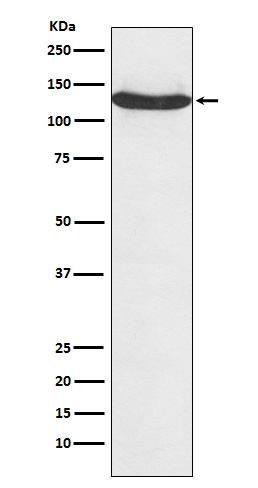hnRNP U Rabbit mAb [sw5N]Cat NO.: A20309
Western blot(SDS PAGE) analysis of extracts from K562 cell lysate.Using hnRNP U Rabbit mAb [sw5N]at dilution of 1:1000 incubated at 4℃ over night.
Product information
Protein names :HNRNPU; HNRPU; p120; pp120; SAFA;
UniProtID :Q00839
MASS(da) :90,584
MW(kDa) :120kDa
Form :Liquid
Purification :Affinity-chromatography
Host :Rabbit
Isotype : IgG
sensitivity :Endogenous
Reactivity :Human,Mouse,Rat
- ApplicationDilution
- 免疫印迹(WB)1:1000-2000
- 免疫组化(IHC)1:100
- 免疫荧光(ICC/IF)1:100
- The optimal dilutions should be determined by the end user
Specificity :Antibody is produced by immunizing animals with A synthesized peptide derived from human hnRNP U
Storage :Antibody store in 10 mM PBS, 0.5mg/ml BSA, 50% glycerol. Shipped at 4°C. Store at-20°C or -80°C. Products are valid for one natural year of receipt.Avoid repeated freeze / thaw cycles.
WB Positive detected :K562 cell lysate.
Function : DNA- and RNA-binding protein involved in several cellular processes such as nuclear chromatin organization, telomere-length regulation, transcription, mRNA alternative splicing and stability, Xist-mediated transcriptional silencing and mitotic cell progression (PubMed:10490622, PubMed:18082603, PubMed:19029303, PubMed:22325991, PubMed:25986610, PubMed:28622508). Plays a role in the regulation of interphase large-scale gene-rich chromatin organization through chromatin-associated RNAs (caRNAs) in a transcription-dependent manner, and thereby maintains genomic stability (PubMed:1324173, PubMed:8174554, PubMed:28622508). Required for the localization of the long non-coding Xist RNA on the inactive chromosome X (Xi) and the subsequent initiation and maintenance of X-linked transcriptional gene silencing during X-inactivation (By similarity). Plays a role as a RNA polymerase II (Pol II) holoenzyme transcription regulator (PubMed:8174554, PubMed:9353307, PubMed:10490622, PubMed:15711563, PubMed:19617346, PubMed:23811339). Promotes transcription initiation by direct association with the core-TFIIH basal transcription factor complex for the assembly of a functional pre-initiation complex with Pol II in a actin-dependent manner (PubMed:10490622, PubMed:15711563). Blocks Pol II transcription elongation activity by inhibiting the C-terminal domain (CTD) phosphorylation of Pol II and dissociates from Pol II pre-initiation complex prior to productive transcription elongation (PubMed:10490622). Positively regulates CBX5-induced transcriptional gene silencing and retention of CBX5 in the nucleus (PubMed:19617346). Negatively regulates glucocorticoid-mediated transcriptional activation (PubMed:9353307). Key regulator of transcription initiation and elongation in embryonic stem cells upon leukemia inhibitory factor (LIF) signaling (By similarity). Involved in the long non-coding RNA H19-mediated Pol II transcriptional repression (PubMed:23811339). Participates in the circadian regulation of the core clock component ARNTL/BMAL1 transcription (By similarity). Plays a role in the regulation of telomere length (PubMed:18082603). Plays a role as a global pre-mRNA alternative splicing modulator by regulating U2 small nuclear ribonucleoprotein (snRNP) biogenesis (PubMed:22325991). Plays a role in mRNA stability (PubMed:17174306, PubMed:17289661, PubMed:19029303). Component of the CRD-mediated complex that promotes MYC mRNA stabilization (PubMed:19029303). Enhances the expression of specific genes, such as tumor necrosis factor TNFA, by regulating mRNA stability, possibly through binding to the 3'-untranslated region (UTR) (PubMed:17174306). Plays a role in mitotic cell cycle regulation (PubMed:21242313, PubMed:25986610). Involved in the formation of stable mitotic spindle microtubules (MTs) attachment to kinetochore, spindle organization and chromosome congression (PubMed:21242313). Phosphorylation at Ser-59 by PLK1 is required for chromosome alignement and segregation and progression through mitosis (PubMed:25986610). Contributes also to the targeting of AURKA to mitotic spindle MTs (PubMed:21242313). Binds to double- and single-stranded DNA and RNA, poly(A), poly(C) and poly(G) oligoribonucleotides (PubMed:1628625, PubMed:8068679, PubMed:8174554, PubMed:9204873, PubMed:9405365). Binds to chromatin-associated RNAs (caRNAs) (PubMed:28622508). Associates with chromatin to scaffold/matrix attachment region (S/MAR) elements in a chromatin-associated RNAs (caRNAs)-dependent manner (PubMed:7509195, PubMed:1324173, PubMed:9204873, PubMed:9405365, PubMed:10671544, PubMed:11003645, PubMed:11909954, PubMed:28622508). Binds to the Xist RNA (PubMed:26244333). Binds the long non-coding H19 RNA (PubMed:23811339). Binds to SMN1/2 pre-mRNAs at G/U-rich regions (PubMed:22325991). Binds to small nuclear RNAs (snRNAs) (PubMed:22325991). Binds to the 3'-UTR of TNFA mRNA (PubMed:17174306). Binds (via RNA-binding RGG-box region) to the long non-coding Xist RNA,this binding is direct and bridges the Xist RNA and the inactive chromosome X (Xi) (By similarity). Also negatively regulates embryonic stem cell differentiation upon LIF signaling (By similarity). Required for embryonic development (By similarity). Binds to brown fat long non-coding RNA 1 (Blnc1),facilitates the recruitment of Blnc1 by ZBTB7B required to drive brown and beige fat development and thermogenesis (By similarity).., (Microbial infection) Negatively regulates immunodeficiency virus type 1 (HIV-1) replication by preventing the accumulation of viral mRNA transcripts in the cytoplasm..
Tissue specificity :Widely expressed..
Subcellular locationi :Nucleus. Nucleus matrix. Chromosome. Nucleus speckle. Cytoplasm, cytoskeleton, microtubule organizing center, centrosome. Chromosome, centromere, kinetochore. Cytoplasm, cytoskeleton, spindle. Cytoplasm, cytoskeleton, spindle pole. Midbody. Cytoplasm. Cell surface. Cytoplasmic granule.
IMPORTANT: For western blots, incubate membrane with diluted primary antibody in 1% w/v BSA, 1X TBST at 4°C overnight.


